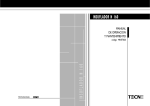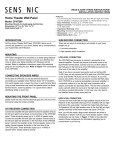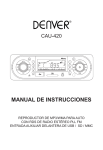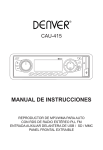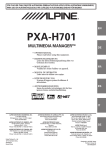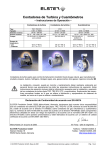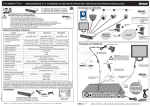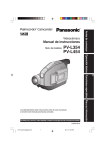Download 61807 CPHT200WH
Transcript
READ & SAVE THESE INSTRUCTIONS! INSTALLATION INSTRUCTIONS Home Theater Wall Panel Model: CPHT200WH (White) CPHT200 (Black) Mounting: Mounts on double gang electrical box Dimensions: 45⁄8" H x 49⁄16" W x 15⁄16" D Depth behind wall: 7⁄16" INTRODUCTION NuTone Home Theater Wall Panel, allows you to connect the speakers in your home theater set up conveniently to your Audio/Video (A/V) Receiver. Features: • For connecting the Front left and right, Rear left and right and center channel speakers including a sub-woofer in a home theater set up • Input Terminals: Accepts up to 14 AWG wires • Output Terminals: Via speaker push type terminals which accept up to 14 AWG wires • Impedance Matching: None • Mounting: Standard Double gang electrical box • Dimensions: 45⁄8" H x 49⁄16" W x 15⁄16" D • Depth Behind Wall: Appx. 7⁄16" There are two ways of connecting a sub-woofer to your home theater set up: 1. Low level connection 2. High (speaker level) connection MOUNTING LOW LEVEL CONNECTION: Designed to be mounted on a double gang electrical box. Choose a convenient location to mount your electrical box close to where your stereo amplifier (A/V Receiver) will be located. Refer to installation instructions sheet of the electrical gang box for mounting the box. Refer to Figure 1 for connections. Has provisions to connect a sub-woofer to an external amplifier. Connect the passive sub-woofer wires to the SubWoofer terminal block. Connect one end, an RCA cable to the RCA jack on the front face of the and connect the other end of the cable to the amplifier. CONNECTING SPEAKERS WIRES At the back you will see terminal blocks for connecting your speaker wires. Remove about 1/4" of insulation from each speaker wire. Loosen the screw on each terminal block using a small screwdriver and insert the speaker wires into these terminal blocks, observing polarity. It is a good idea to attach identifying labels on each wire. MOUNTING THE FRONT PANEL Gently insert the wires into the electrical gang box and mount the front panel using the screws provided. A/V RECEIVER CONNECTION Connect the amplifier left and right front channel speaker wires to the left and right front terminals on the front face of the panel. These terminals accept up to 14 AWG of speaker wires. Connect the amplifier left and right rear speaker channel wires to the left and right rear terminals on the front face of the panel. Connect the amplifier center channel speaker wires to the center channel speaker terminals on the front face of the panel. These terminals accept up to 14 AWG of speaker wires. Always observe polarity. SUB-WOOFER CONNECTION Note: If you have a powered sub-woofer such as ES4110PSL, then you will connect the RCA cable from panel to the “Sub-Woofer” RCA jack on the A/V receiver. If you have passive sub-woofer, then you will need to connect the RCA cable to an external preamplifier and power amplifier. A convenient method is to use the high level connection with a passive sub-woofer as described below. The low level connection works well with either the low level or the high level connection if you have a powered subwoofer. In this case, you may need to use shielded wires to keep noise level low. HIGH LEVEL CONNECTION: Connect the front (main) left and right speaker wires from the A/V Receiver to the Input Side (that says From Amplifier) left and right terminals of the sub-woofer. Connect the Output Side (that says To Speakers) left and right speaker wires to the front left and right speaker terminals of the home theater wall panel. Now, you will also need a large screen television and either a DVD player or Stereo VCR for your home theater system. These components are not shown in Figure 1. Refer to the instruction sheets of these components for information regarding how to connect them in your set up. TO AMPLIFIER/RECEIVER HOME THEATER WALL PANEL CPHT200WH CPHT200 CONNECT SPEAKER WIRES TO TO AMPLIFIER/RECEIVER THE RESPECTIVE TERMINAL BLOCKS REAR VIEW TO AMPLIFIER/RECEIVER FRONT VIEW TERMINAL BLOCK FIGURE 1 TESTING THE SYSTEM There are two ways of testing your home theater system. 1. Using your A/V Receiver’s Test Tone: Keep the volume control on the A/V Receiver at some low setting (1/4th of its maximum position). Keep the tone controls (Bass and Treble) at their mid position. On most A/V Receivers there is a button called “Test Tone”. If you select this button, you will hear a hissing type of sound (called white or pink noise) coming from the Main Front Left, Center, Main Front Right and Rear (Surround) speakers in that order. This sound sequence will keep repeating itself until you defeat the Test Tone button. (Most A/V Receivers will also allow you to increase or decrease the volume of the Center Channel speaker and Rear speakers with respect to the Main speaker). If no sound is heard from any speaker(s), check the Troubleshooting Guide. 2. Using a sound source: The other method of testing your system is to play music from a source such as a CD player. Make sure you have selected “CD” player on the A/V Receiver. Play music. You should hear sound from your speakers. (Note: read the operating instructions that came with Receiver carefully. Most Receivers cut off sound to the Center Channel speaker if they are in Stereo mode or Bypass mode). TROUBLESHOOTING GUIDE Symptom Possible Cause Possible Remedy 1. No sound from either speaker. 1. Improper source selected at amplifier. 2. Mute button pressed. 3. Wrong speaker output selected A or B. 4. Amplifier shuts off because of short circuit. 1. Select proper source. 2. Defeat Mute button. 3. Select proper position on A/B switch. 4. Check all wires and remove the short. Check proper operation of Amplifier/Receiver. 2. Sound from only one speaker. 1. There is missing connection. 2. Balance control on amplifier turned all the way to left or right. 1. Check all wires and make all connections. 2. Set the control to mid position. 3. Low bass sound. 1. Wrong polarity on one speaker. 1. Check polarity & rewire, if necessary. 4. Amplifier shuts off as volume is increased. 1. Amplifier is overloaded. 1. Short circuit in wire. Check all wires & remove short. Product specifications subject to change without notice. 4820 Red Bank Road, Cincinnati, Ohio 45227 Printed in China, Rev. 08/07/06, Part No. 61807 ! LEA Y GUARDE ESTAS INSTRUCCTIONES! INSTRUCCIONES DE INSTALACIÓN CaracterÌsticas: • Para conectar los canales de los parlantes frontales y posteriores, izquierdos y derechos, y el central en un sistema de cine en su casa. Modelo: CPHT200WH (Blanco) CPHT200 (Negro) • Terminales de entrada: Acepta alambres de hasta calibre 14. • Terminales de salida: Mediante terminales de parlante tipo enchufe que Montaje: Se monta en caja de electricidad de tándem de dos aceptan alambres de hasta calibre 14. unidades Dimensiones: 45⁄8" (11,7 cm) de alto por 49⁄16" (11,6 cm) de ancho • Adaptación de impedancia: Ninguna. • Montaje: Caja de electricidad estándar de tándem de dos unidades. por 15⁄16" (3,3 cm) de profundidad • Dimensiones: 4-5/8" (11,7 cm) de alto por 4-9/16" (11,6 cm) de ancho por Profundidad detrás de la pared: 7⁄16" (1 cm) 1-5/16" (3,3 cm) de profundidad • Profundidad detrás de la pared: 7/16" (1 cm) Panel de pared para cine en su casa INTRODUCCIÓN El Panel de pared para cine en su casa y de NuTone la permite conectar de forma conveniente los parlantes de su systema de cine doméstico al receptor de audio y video (A/V). MONTAJE El panel ha sido diseñado para montarlo sobre una caja de electricidad de tándem de dos unidades. Escoja una ubicación conveniente para montar la caja de electricidad cerca de dónde estará ubicado el amplificador estéreo (receptor A/V0. Vea las instrucciones de instalación de la caja de electricidad para amarla apropiadamente. Vea la figura 1 con respecto a las conexiones al panel. CONEXIÓN DE CABLES DE LOS PARLANTES En la parte posterior del panel verá bloques terminales para conectar los cables de los parlantes. Quite aproximadamente 1/4" (1/2 cm) de aislante de los cables del parlante e insértelos en estas terminales, observanco la polaridad. Es recomendable poner etiquetas de identificación en cada cable. Hay dos maneras de conectar un altavoz de ultragraves al sistema de cine en su casa: 1. Conexión de nivel bajo 2. Conexión de nivel alto (nivel del parlante) CONEXIÓN DE NIVEL BAJO: Brinda la posibilidad de conectar un altavoz de untragraves a un amplificador externo. Conecte los cables pasivos del altavoz de ultragraves al bloque de terminales del mismo. Conecte un extremo, un cable RCA al enchufe RCA del frente del y conecte el otro extremo del cable al amplificador. Nota: Si tiene un altavoz de ultragraves potenciado, como el ES4110PSL, debe conectar el cable RCA del panel al enchufe RCA “Sub-Woofer” en el receptor A/V. Si tiene un altavoz de ultragraves pasivo, debe conectar el cable RCA del a un preamplificador externo y amplificador potenciado. Un buen método es utilizar la conexión de nivel alto con un altavoz de ultragraves pasivo como se describe más adelante. La conexión funciona bien tanto con la conexión baja como con la alta si se dispone de un altavoz de ultragraves potenciado. En dicho caso, es posible que deba utilizar cables blindados para disminuir el ruido. MONTAJE DEL PANEL FRONTAL Inserte con cuidado los cables en la caja de electricidad de tándem de dos unidades y arme el panel frontal con los tornillos disponibles. CONEXIÓN DEL RECEPTOR A/V Conecte los cables del amplificador de los canales de los parlantes frontales izquierdo y derecho a las terminales designadas de izquierda frontal y derecha frontal en la parte frontal del panel del. Dichas terminales aceptan alambres de hasta calibre 14. Conecte los cables del amplificador de los canales de los parlantes posteriores izquierdo y derecho a las terminales designadas de izquierda posterior y derecha posterior en la parte fronmtal del panel del. Dichas terminales aceptan alambres de hasta calibre 14. Conecte los cables del amplificador del canal del parlante central a la terminale designada central en la parte frontal del panel del. Dicha terminal acepta alambres de hasta calibre 14. Siempre observe la polaridad. CONEXIÓN DEL ALTAVOZ DE ULTRAGRAVES CONEXIÓN DE NIVEL ALTO: Conecte los cables de los parlantes frontales (principales) izquierdo y derecho desde el receptor A/V a las terminales izquierda y derecha del lado de entrada (que dice “From Amplifier” [desde el amplificador]) del altavoz de ultragraves. Conecte los cables de los parlantes izquierdo y derecho del lado de salida (que dice “To Speakers” [a los parlantes] a las terminales de los parlantes izquierdo y derecho del panel de pared para cine en su casa modelo. Para el sistema de cine en su casa también necesitará un televisor de pantalla grande y un reproductor de DVD o un videograbador estéreo. Dichos componentes no se muestran en la figura 1. Vea las instrucciones de los mismos para informarse sobre cómo conectarlos a su sistema PANEL DE PARED PARA CINE EN SU CASA CPHT200WH CPHT200 A AMPLIFICADOR O RECEPTOR CONECTAR LOS CABLES DEL PARLANTE A LOS A AMPLIFICADOR O RECEPTOR BLOQUES DE TERMINALES RESPECTIVOS BLOQUE DE TERMINALES A AMPLIFICADOR O RECEPTOR VISTA FRONTAL VISTA POSTERIOR FIGURA 1 PREUBA DEL SISTEMA Existen dos maneras de probar el sistema de cine en su casa. 1. Mediante el sistema de prueba de tono del Receptor A/V: Ponga el control del volumen del receptor A/V en un nivel bajo (1/4 de su posición máxima). Ponga los controles del tono (bajos y agudos) en la posición media. En la mayoría de los receptores A/V hay un botón llamado “Prueba de tono” (Test Tone). Si selecciona este botón, oirá un sonido como de silbido (denominado “sonido blanco o rosado”) que se transmite por todos los parlantes (sorround); dicho sonido parte desde el parlante frontal izquierdo, sigue en el central, pasa por el frontal derecho y termina en los posteriores. Esta secuencia sonora seguirá repitiéndose hasta que vuelva a oprimir el botón Test Tone. (La mayorÌa de los receptores A/V también le permiten subir o bajar el volumen del parlante central y de los posteriores con respecto al parlante principal.) Si no se oye ningún sonido de uno o más parlantes, vea la Guía de Soluciones de Problemas. 2. Mediante una fuente de sonido: La otra manera de probar el sistema es reproducir música a través de una fuente de sonido, como un reproductor de CD. Asegúrese de haber seleccionado “CD” en el receptor A/V. Al tocar la música, debe salir el sonido por los parlantes. (NOTA: La mayoría de los receptores anulan el sonido del canal central si están en modalidad estéreo o “bypass”. Lea las instrucciones de operación que vinieron con el receptor. GUÍA DE SOLUCIÓN DE PROBLEMAS Síntoma Posible causa Posible solución 1. No sale sonido de ningún parlante. 1. Se ha seleccionado una fuente equivocada en la amplificador. 2. Se ha oprimido el botón silenciador (Mute). 3. Se ha seleccionado mal la salida del parlante, A o B. 4. El amplificador se apaga debido a un corto circuito. 1. Selecciones la fuente correcta. 2. Desactive el botón silenciador. 3. Seleccione la posición en el interruptor A/B. 4. Revise todos los cables y elimine el corto circuito. Verifique que el amplificador/receptor funcione correctamente. 2. Sale sonido de un solo parlante. 1. Falta una conexión. 2. El control del amplificador está puesto totalmente a la izquierda o la derecha. 1. Revise todos los cables y haga las conexiones necesarias. 2. Ponga el control en la posición media. 3. Poco sonido de graves. 1. Error de polaridad en uno de los parlantes. 1. Verifique la polaridad y vuelva a conectar los cables, de ser necesario. 4. El amplificador se apaga cuando se sube el volumen. 1. El amplificador está sobrecargado 1. Puede haber un corto circuito. Revise todos los cables y elimínelo. Las especificaciones del producto están sujetas a cambio sin previo aviso. 4820 Red Bank Road, Cincinnati, Ohio 45227 Impreso en China, Rev. 08/07/06, Part No. 61807










